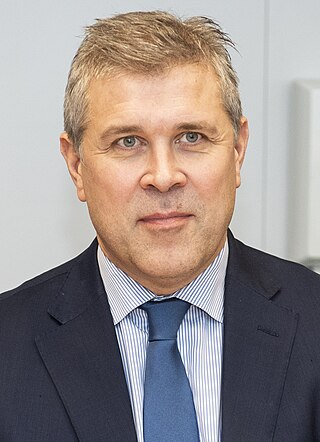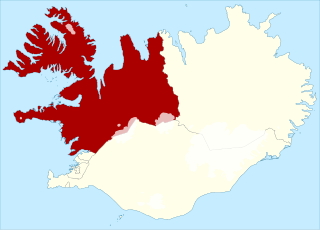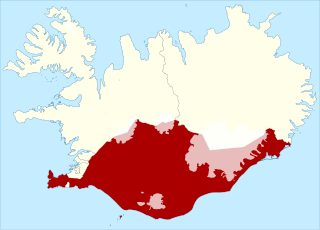
The politics of Iceland take place in the framework of a parliamentary representative democratic republic, whereby the president is the head of state, while the prime minister of Iceland serves as the head of government in a multi-party system. Executive power is exercised by the government. Legislative power is vested in both the government and the parliament, the Althingi. The judiciary is independent of the executive and the legislature.

The Social Democratic Alliance is a social democratic political party in Iceland. The party is positioned on the centre-left of the political spectrum and their leader is Kristrún Frostadóttir, who has been leader since 2022, and has served as Prime Minister of Iceland since 21 December 2024.

The Progressive Party is an agrarian political party in Iceland.

The Left-Green Movement, also known by its short-form name Vinstri græn (VG), is an eco-socialist political party in Iceland.

Iceland is heavily integrated into the European Union via the Agreement on the European Economic Area and the Schengen Agreement, despite its status as a non-EU member state. Iceland applied for membership in 2009. The Minister for Foreign Affairs sent a letter in 2015 that ended the application process.
Parliamentary elections were held in Iceland on 12 May 2007. The Independence Party remained the largest party in the Althing, winning 25 of the 63 seats. Following the elections, a coalition government was formed by the Independence Party and the Social Democratic Alliance, with Geir Haarde continuing as Prime Minister.
Sturla Jónsson, formerly known as the Progress Party, was an Icelandic political party. The party was known as the Progress Party from its founding on 17 December 2008 to 5 April 2013 when it was renamed after its founder.
Snap parliamentary elections were held in Iceland on 25 April 2009, following strong pressure from the public as a result of the Icelandic financial crisis. The Social Democratic Alliance and the Left-Green Movement, which formed the outgoing coalition government under Prime Minister Jóhanna Sigurðardóttir, both made gains and formed an overall majority of seats in the Althing. The Progressive Party also made gains, and the new Citizens' Movement, formed after the January 2009 protests, won four seats. The big loser was the Independence Party, which had been in power for 18 years until January 2009; it lost nine seats as its vote share was reduced by around a third, meaning it was not the most voted-for party for the first time since 1937

Katrín Jakobsdóttir is an Icelandic politician who served as the prime minister of Iceland from December 2017 to April 2024 and was a member of the Althing for the Reykjavík North constituency from 2007 to 2024.

Bjarni Benediktsson, known colloquially as Bjarni Ben, is an Icelandic former politician who served as the prime minister of Iceland from January to November 2017 and again from April to December 2024. He has been the leader of the Icelandic Independence Party since 2009, and served as the minister of finance and economic affairs from 2013 to 2017, a post he later retained under Katrín Jakobsdóttir and held until his resignation in October 2023. After serving briefly as the minister for foreign affairs from 2023 to 2024, Bjarni became prime minister again on 9 April 2024.
Bjarni Harðarson is a bookseller, novelist, and former MP from the Icelandic Progressive Party.

Northwest is one of the six multi-member constituencies of the Althing, the national legislature of Iceland. The constituency was established in 2003 following the re-organisation of constituencies across Iceland when the Northwestern constituency was merged with the Western and Westfjords constituencies. Northwest consists of the regions of Northwestern, Western and Westfjords. The constituency currently elects six of the 63 members of the Althing using the open party-list proportional representation electoral system. At the 2024 parliamentary election it had 22,351 registered electors.

South is one of the six multi-member constituencies of the Althing, the national legislature of Iceland. The constituency was established in 2003 following the re-organisation of constituencies across Iceland when the Southern constituency was merged with municipalities of Gerðahreppur, Grindavík, Reykjanesbær, Sandgerði and Vatnsleysustrandarhreppur from the Reykjanes constituency and the municipality of Sveitarfélagið Hornafjörður from the Eastern constituency. South consists of the Southern and Southern Peninsula regions. The constituency currently elects nine of the 63 members of the Althing using the open party-list proportional representation electoral system. At the 2024 parliamentary election it had 41,002 registered electors.

Southwest is one of the six multi-member constituencies of the Althing, the national legislature of Iceland. The constituency was established in 2003 following the re-organisation of constituencies across Iceland when the Reykjanes constituency was split between the new South and Southwest constituencies. Southwest is conterminous with the Capital region but excludes Reykjavík Municipality which has its own constituencies, Reykjavík North and Reykjavík South. The constituency currently elects 12 of the 63 members of the Althing using the open party-list proportional representation electoral system. At the 2024 parliamentary election it had 79,087 registered electors.

People's Front of Iceland is an anti-capitalist political party in Iceland founded on 18 February 2013, seeking to "... free the people from the yoke of market capitalism". It is "unconditionally opposed" to Iceland's accession to both the European Union and NATO, believing them to be "imperialist" organisations. The party founder, Þorvaldur Þorvaldsson, is a self-declared communist.
Rainbow is a Eurosceptic and socialist political party in Iceland, founded in March 2013 by former MP Bjarni Harðarson, who had been elected for the Progressive Party, and current MPs Jón Bjarnason and Atli Gíslason, both dissidents from the Left-Green Movement (VG). The party was founded in order to contest the 2013 Icelandic parliamentary election.
Parliamentary elections were held in Iceland on 29 October 2016. They were due to be held on or before 27 April 2017, but following the 2016 Icelandic anti-government protests, the ruling coalition announced that early elections would be held "in autumn".

Early parliamentary elections were held in Iceland on 28 October 2017. On 15 September 2017, the three-party coalition government collapsed after the departure of Bright Future over a scandal involving Prime Minister Bjarni Benediktsson's father writing a letter recommending a convicted child sex offender have his "honour restored". Bjarni subsequently called for a snap election, which was officially scheduled for 28 October 2017 following the dissolution of the Althing.

Parliamentary elections were held in Iceland on 25 September 2021 to elect the members of the Althing. Following the elections, the three parties in the ruling coalition government – the Independence Party, Progressive Party and Left-Green Movement – agreed to continue in office, with Katrín Jakobsdóttir of the Left-Green Movement remaining Prime Minister despite her party being the smallest of the three. It was the first time an incumbent government had retained power in an election since the 2008 financial crisis.

Parliamentary elections were held in Iceland on 30 November 2024 to elect the 63 members of the Althing. The centre-left Social Democratic Alliance, led by Kristrún Frostadóttir, outperformed the ruling Independence Party to win the most seats, at 15. The election saw the worst performance by the Independence Party, Progressive Party, the Left-Green Movement, and the Pirate Party in each of the parties' histories, while Viðreisn, the People's Party, and the Centre Party saw their best performance in each of the parties' histories. This follows a trend of Icelanders voting against every post–2008 recession government except during the 2021 election.


















